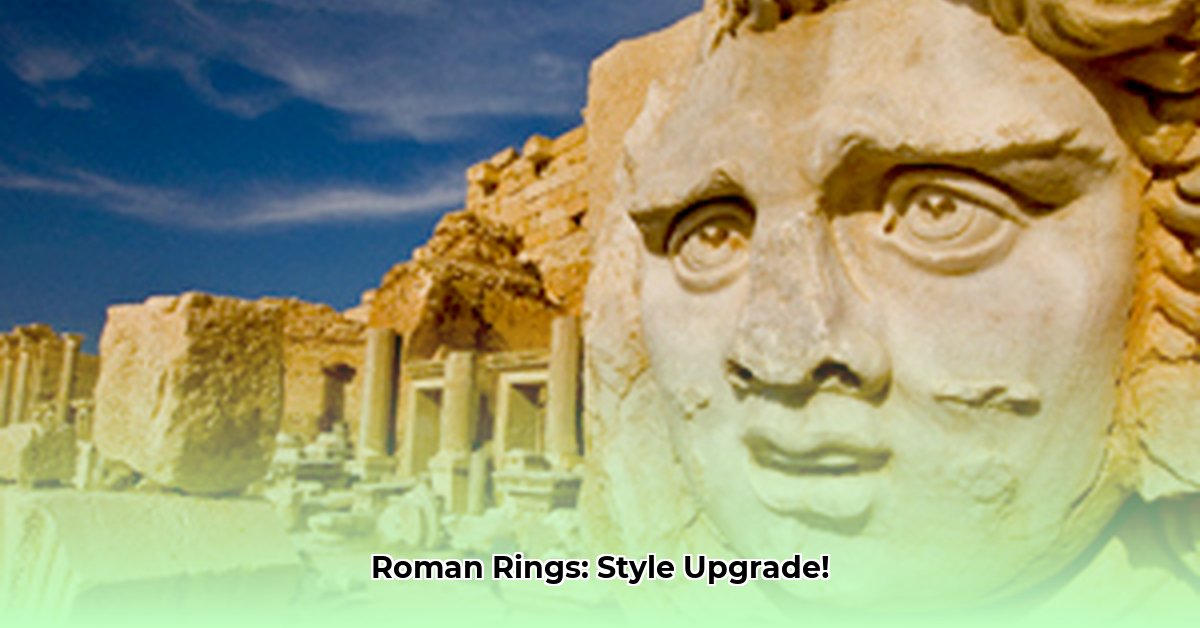Have you ever considered the profound statements made by jewelry in ancient Rome? Far from being mere ornaments, these intricate pieces were powerful declarations of identity, wealth, and belief. From the dazzling gold worn by senators to the protective amulets safeguarding children, Roman jewelry was a complex tapestry woven from precious metals, vibrant gemstones, and skilled craftsmanship, often influenced by the rich traditions of Greece, Egypt, and the Etruscans.
This comprehensive exploration will delve into what made Roman adornments so pivotal, how master artisans brought them to life, and how their enduring appeal continues to shape modern aesthetics. We will unveil the secrets of authenticating ancient pieces, guide you through selecting Roman-inspired replicas, and provide essential tips for preserving these historical, or historically-influenced, treasures. Prepare to journey back in time and discover how the legacy of Roman jewelry can beautifully integrate into your contemporary style.
The Grandeur of Roman Adornment: Beyond Mere Decoration
In the bustling forums and opulent villas of ancient Rome, jewelry transcended simple aesthetics. It served as a multifaceted language, instantly communicating an individual’s financial standing, social status, and deeply held convictions. This glittering form of communication was a visual resume in a society keenly aware of hierarchy and public presentation.
Status, Wealth, and Social Stratification
Romans were unreserved in showcasing their affluence and position through their adornments. The more elaborate and costly a piece, the higher the individual’s social standing. Dazzling gold rings, necklaces laden with imported gemstones like emeralds, pearls, and amethysts, and intricate designs not only proclaimed wealth but also underscored political influence. For instance, while gold rings were reserved for men of senatorial rank and equestrians, plebeians typically wore iron rings, except when a gold one was bestowed as a mark of honor. Sumptuary laws, though not always strictly enforced, further regulated the display of luxury, reinforcing socio-economic stratification.
Women, particularly elites, often wore an abundant array of extravagant and expensive gold jewelry, reflecting not only their personal wealth but also their familial status. These pieces were uniquely considered their own property, giving Roman women unusual financial autonomy to buy, sell, or bequeath them. This lavish ornamentation extended beyond life, with rich funerary jewelry often interred with the deceased to signify their esteemed status even in the afterlife, a practice that gained popularity after the sack of wealthy Greek cities like Tarentum.
Symbolism, Protection, and Personal Expression
Beyond ostentation, Roman jewelry held profound spiritual and personal meaning. Many pieces served as powerful protective amulets, believed to ward off evil and ensure the wearer’s well-being. Children, especially young boys, famously wore the bulla, a hollow golden locket containing charms, suspended around their necks until they reached adulthood, symbolizing protection from malevolent forces. Similarly, the phallic fascinus was commonly worn or placed near young boys for protection.
Other motifs carried rich symbolism:
* The Eagle: Representing power, authority, and the Roman Empire’s dominance.
* The Dolphin: Emblematic of love, fidelity, and good fortune, often exchanged between lovers.
* Venus: The goddess of love and beauty, her image or symbols like the shell were cherished by women as talismans of passion and femininity.
* The Laurel Wreath: A symbol of victory and achievement, adorning emperors, military heroes, and athletes.
* The Serpent: A powerful motif symbolizing transformation, renewal, immortality, and healing, often depicted as coiling snakes.
A Tapestry of Cultural Influence
Roman artisans were exceptionally skilled and adaptable, constantly integrating diverse cultural influences gained through the vast expansion of the Roman Empire and its extensive trade networks. Early Roman jewelry reflected strong Etruscan techniques like granulation (fusing tiny metal balls onto a surface) and filigree (delicate wirework). Later, intricate Greek designs and the use of precious stones became staples. From Egypt, Romans adopted a strong interest in colored gemstones and glass.
Control over Mediterranean territories provided an abundance of natural resources. Trade routes, notably the Silk Road from the East, facilitated access to exotic semi-precious and precious stones. Garnets, emeralds, jasper, and lapis lazuli were imported from Egypt, while onyx, amber, and moonstone traveled from the Persian Gulf. This cultural amalgamation resulted in a diverse assortment of designs, often valuing ostentatious and creative use of color over fine metalwork, sometimes even deceiving the public with meticulously crafted glass mimicking genuine gems.
The Masterful Craft of Roman Jewelers
The artistry of Roman jewelers reflected a society that balanced mass production with exquisite individual craftsmanship. Their material choices and techniques showcased remarkable innovation and adaptability.
Precious Materials and Ingenious Substitutes
Gold was paramount, favored for its luster and association with divine power and status. Silver, prized for its availability and elegant appeal, was also widely used. Less expensive metals like bronze and iron were employed for more accessible pieces, allowing broader segments of society to afford adornments.
Roman appreciation for color led to the widespread use of gemstones and colored glass. Highly prized gems included:
* Emeralds: Sought after for their vibrant green, symbolizing fertility and rebirth.
* Pearls: Coveted for their purity and natural beauty, often fetched from the Mediterranean and Red Seas, and used in elaborate earrings known as crotalia (rattles) until the end of the Republic.
* Garnets: With their rich reddish hue, symbolizing passion and vitality.
* Lapis Lazuli: Known for its deep blue, symbolizing royalty and power.
* Amethysts: Revered for their deep purple, believed to possess protective and healing properties.
A testament to Roman ingenuity was their masterful use of glass as a substitute for costly gems. Glassmakers were so skilled they created intricate, colorful glass beads and ornaments that could fool the public into believing they were genuine gemstones. Towards the Imperial Period, advances in glasswork saw the incorporation of millefiori, a technique featuring flower-like patterns within glass.
Artisan Techniques: From Filigree to Casting
Roman jewelers employed a range of sophisticated techniques:
* Filigree and Granulation: These delicate metalworking techniques, inherited from the Etruscans and Greeks, allowed for the creation of intricate, refined pieces, especially in gold.
* Casting and Molding: Unlike their Greek predecessors who focused on unique, high-quality metalwork by practiced artisans, Roman manufacturers embraced mass production using molds and casting techniques. This made jewelry more affordable and accessible to a wider populace.
* Engraving and Intaglio: Often seen on rings, these techniques involved carving designs into gemstones or metal, creating raised or sunken patterns.
* Beading: Mastering the art of threading tiny glass beads together, Roman artisans created complex and detailed patterns on earrings, necklaces, and bracelets.
A Comprehensive Jewelry Box: Types and Their Uses
The variety of jewelry worn by Romans was extensive, catering to different genders, ages, and social ranks.
* Rings: Ubiquitous and highly significant, ranging from practical signet rings (used to seal documents, indicating authority and status) to elegant wedding rings symbolizing marital commitment. Rings were worn by both men and women, often multiple at once.
* Necklaces: Commonly worn by women, these ranged from simple chains to elaborate choker-style pieces adorned with gems, glass beads, or significant pendants featuring gods, goddesses, or religious symbols.
* Earrings: Primarily worn by women, designs varied from simple hoops and studs to elaborate dangling pendants, including the famous pearl crotalia.
* Bracelets: Worn by both men and women on the wrist or upper arm, styles included solid gold snake bracelets, simple bands, or ornate pieces studded with gemstones, some using gold pins or small screws for fastening.
* Fibulae (Brooches): Essential for fastening garments, these also served as decorative and symbolic adornments, ranging from practical bronze pieces to opulent gold brooches encrusted with gemstones. The “crossbow fibula” was particularly notable and could reflect military achievements.
* Bullae: Hollow lockets worn by children as talismans until adulthood, believed to ward off evil.
* Torcs: Rigid neck rings, often symbolizing military prowess and distinction, famously worn by warriors like Titus Manlius Torquatus.
* Other Adornments: This included ornate hairpins, belt buckles, and shoe buckles, which could be as lavish as other jewelry types and sometimes functioned as amulets.
Ancient Roman Rings: Nexus of History and Identity
Among all forms of Roman jewelry, rings held a particularly prominent place, serving as powerful symbols of status, personal expression, and even legal authority.
Rings as Status, Seals, and Sentiments
Ancient Roman rings were far more than mere accessories; they were deeply embedded in daily life and societal structures:
* Signet Rings: Perhaps the most significant, these rings featured intricate intaglio designs—family crests, initials, or professional emblems—used daily to authenticate documents with wax seals. A signet ring wasn’t just decorative; it carried legal weight, with its size and elaboration often directly indicating the wearer’s wealth and importance. Emperors, senators, and high-ranking officials prominently wore them as symbols of power and allegiance.
* Wedding Rings: Central to matrimonial customs, the exchange of Roman wedding rings symbolized love, loyalty, and the eternal union of partners. Made of precious metals and often adorned with intricate designs, they represented a visible pledge of fidelity, a tradition that endures today.
* Tokens of Affection: Beyond formal betrothals, rings were exchanged as tokens of love, friendship, and personal connection.
* Practical Tools: Some rings incorporated small keys or compartments, serving practical functions in daily life.
Decoding Roman Ring Symbolism
Many Roman rings were imbued with profound meaning through their designs and motifs:
* Victory and Achievement: Laurel wreaths were popular on rings, celebrating military triumphs or athletic accomplishments.
* Love and Fertility: Images of Venus or Cupid, as well as specific gemstones like emeralds, conveyed themes of love, beauty, and fertility.
* Protection and Fortune: Motifs like the serpent (for immortality and regeneration), the dolphin (for good fortune), or specific amulet-like stones were believed to protect the wearer.
* Personal Inscriptions: Romans often inscribed messages, names, or symbols on their rings, making them deeply personal. Phrases like “Amor Vincit Omnia” (Love Conquers All) or “DVM SPIRO SPERO” (While I Breathe, I Hope) provided tangible links to the wearer’s beliefs and sentiments, transforming the rings into wearable art.
Iconic Roman Rings: Tales from Antiquity
Several ancient Roman rings have gained fame for their extraordinary craftsmanship and intriguing stories, offering unique glimpses into the past:
* The Ring of Senicianus: A gold ring from the 4th century AD, bearing a curse warning off thieves (“May Senicianus live in suffering”), believed to be a response to its alleged theft. This fascinating artifact highlights Roman superstitions and beliefs.
* The Gemma Augustea: A renowned cameo ring crafted during Emperor Augustus’s reign. This sardonyx masterpiece depicts mythological scenes and portraits, including Augustus himself, standing as a remarkable example of exquisite imperial artistry and propaganda.
* The Ring of Gaius Marius: Believed to have belonged to the famous Roman general, this gold signet ring features an engraved image of a warrior, symbolizing military prowess, leadership, and triumph.
* The Ring of Silvianus: A gold ring linked to the curse on the Ring of Senicianus, suggesting a real-life theft incident that inspired a dark magic ritual, underscoring the intertwining of belief and daily life.
Owning a Piece of History: Authenticating and Collecting Roman Jewelry
For enthusiasts captivated by Roman rings and jewelry, acquiring genuine pieces offers a direct connection to antiquity. However, authenticity and responsible custodianship are paramount.
The Art of Authentication: Safeguarding Your Investment
Before purchasing ancient Roman jewelry, it’s essential to ensure its authenticity to acquire a genuine piece of history, not a clever modern reproduction:
1. Consult Experts: Always seek guidance from a reputable antique jewelry dealer, an established auction house specializing in antiquities, or an archaeologist with expertise in Roman artifacts. Their trained eye is invaluable in discerning inconsistencies in style, materials, construction, and patina.
2. Examine Materials and Techniques: Authentic Roman jewelry typically employs gold, silver, bronze, specific gemstones (garnet, amethyst, carnelian, lapis lazuli), and glass. Be wary of items crafted from modern alloys or plastics attempting to mimic ancient materials. Look for characteristic ancient craftsmanship marks—hand-tooling, subtle irregularities, and wear consistent with significant age—rather than machine-made precision.
3. Analyze Provenance: Whenever possible, acquire pieces accompanied by documented provenance (a detailed record of ownership history, including where and when it was found or purchased). This provides crucial insights into the jewelry’s authenticity and past. Reputable dealers will provide this documentation.
4. Consider Context: Evaluate the circumstances surrounding the jewelry’s discovery or acquisition. Exercise extreme caution with items possessing suspicious or unverifiable origins, as they may be fakes or looted artifacts.
5. Research Thoroughly: Familiarize yourself with known Roman styles, periods, and common materials. Museum collections, such as those at the British Museum or the Metropolitan Museum of Art (which house extensive Roman jewelry, including pieces from the Hoxne Hoard and Villa of the Papyri), offer excellent comparative examples.
Responsible Custodianship: Preserving Ancient Artifacts
If you are fortunate enough to possess a genuine piece of Roman history, its preservation is a significant responsibility. To maintain its beauty and integrity for future generations:
* Storage: Store your ancient Roman jewelry in a cool, dry, and stable environment, away from direct sunlight, extreme temperature fluctuations, and high humidity. Use acid-free, archival storage boxes or display cases to protect them from dust, pollutants, and potential damage.
* Handling: Always handle artifacts with clean hands or wear cotton gloves to prevent the transfer of oils, acids, and dirt from your skin, which can cause corrosion or tarnishing over time.
* Cleaning: Avoid using harsh chemicals, abrasive cleaners, or ultrasonic cleaners, as these can severely damage delicate materials, patinas, and settings. Generally, only dust gently with a soft, lint-free cloth










